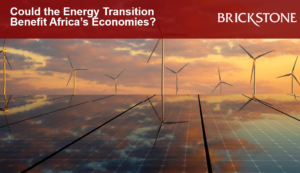7 Facts about Low-Cost Finance For The Energy Transition
According to IRENA, the need to scale up the deployment of technologies such as green hydrogen, energy storage and offshore wind has become increasingly critical to the success of the global energy transition and to meeting global climate goals. To this end, access to low-cost capital for project financing in G20 Member Countries and beyond is vital.
However, this remains challenging – particularly amid the current global tightening of monetary policies – given that a substantial portion of the necessary investment in energy transition technologies has yet to be sourced.
This article by Brickstone Africa reviews IRENA’s publication on low-cost finance for energy transition, highlighting key facts and insights.
Financing Global Energy Transition
International Renewable Energy Agency (IRENA)’s report in close collaboration with the Ministry of New and Renewable Energy (MNRE) of India, aims to facilitate the discussion of this vital aspect of the transition under India’s G20 Presidency. The report offers lessons from historical cost reduction trends for solar PV and onshore wind technologies, enabling innovative frameworks that can be adopted to accelerate the deployment of new and critical low-carbon technologies, and projected investment requirements for the global energy transition.
Africa’s renewable energy transition is fundamental to the continent’s future as Africa is projected to be the home of 2 billion people by 2050. Eighty percent of them will live in Sub-Saharan Africa, where less than half of all people have access to electricity today, and as little as 16% have access to clean cooking fuels and technologies.
The report also highlights the need to mobilise the resources of the private sector, given the limited resources of the public sector; active private sector engagement is vital, particularly in offering low-cost capital for financing energy transition projects. The catalysing role played by the public sector is also discussed in the context of the need for deeper public-private collaboration on the journey to a net-zero future.
Finally, the report stresses the importance of developing a better understanding of the key drivers of the cost of capital for different technologies and markets.
The following are key facts and insights from the publication:
The energy transition requires significant annual investment if governments around the world are to achieve the 1.5°C climate targ they committed to under the Paris Agreement. To reach and sustain these volumes over the coming decades, it is essential to ensure that low-cost finance for the energy transition is available to emerging market economies and advanced economies alike.
Crucially, enabling innovative frameworks that reduce the transaction costs of technology transfers and facilitate foreign has proved successful for wind and solar direct investments have played a key role in accelerating the deployment of new and critical low-carbon technologies in emerging markets.
The majority of the funds required for the energy transition will have to come from the private sector. Capital needs to be urgently mobilised from the domestic and international capital resources of the private sector. Domestic financial markets are critical sources of capital for financing the energy transition since they provide diversified funding sources, access to local equity capital and corporate bond markets, and much-needed local-currency financing to avoid currency risk and help mitigate macroeconomic shocks.
Governments can set the conditions for private sector actors to build and finance a viable pipeline of transition-oriented projects. For example, in a blended finance structure, the public sector strategically provides small amounts of concessional public capital to mitigate certain risks that private sector capital cannot (yet) absorb, or for which they would demand a very high price (rate of return).
Innovation is vital if governments are to scale up new and critical energy transition technologies. Along with economies of scale as markets grow, innovation is one of the main levers available to reduce technology costs, accelerate market penetration and unlock required financial resources. Effective innovation frameworks incorporate coordinated policies and actions to drive innovations in four areas – namely, enabling technologies, business models, market design and system operation – to address the key challenges facing a specific technology in its scale-up.
For green hydrogen, the prospect of significant global trade arising from support policies on the supply and demand sides introduces new considerations. For instance, to help the scale-up of green hydrogen, a transparent and internationally accepted certification system will help accelerate the development of a global hydrogen market with buyers’ and sellers’ assurance of the provenance of the hydrogen.
Mapping and understanding the drivers behind financing costs and conditions are crucial to gaining insights regarding differences by technology and country. This can then allow industry and policy makers to work together to identify the policies and actions needed to allow low-cost capital to flow to the investment needs of the energy transition in a timely manner.
Download the full report here.






